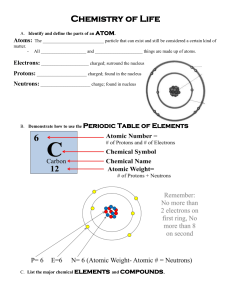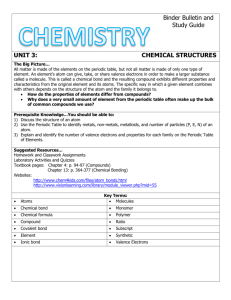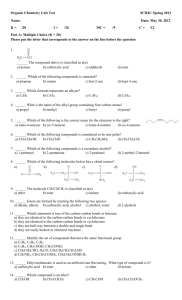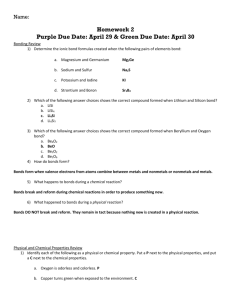Summary Tables for Naming Carbon Compounds
advertisement
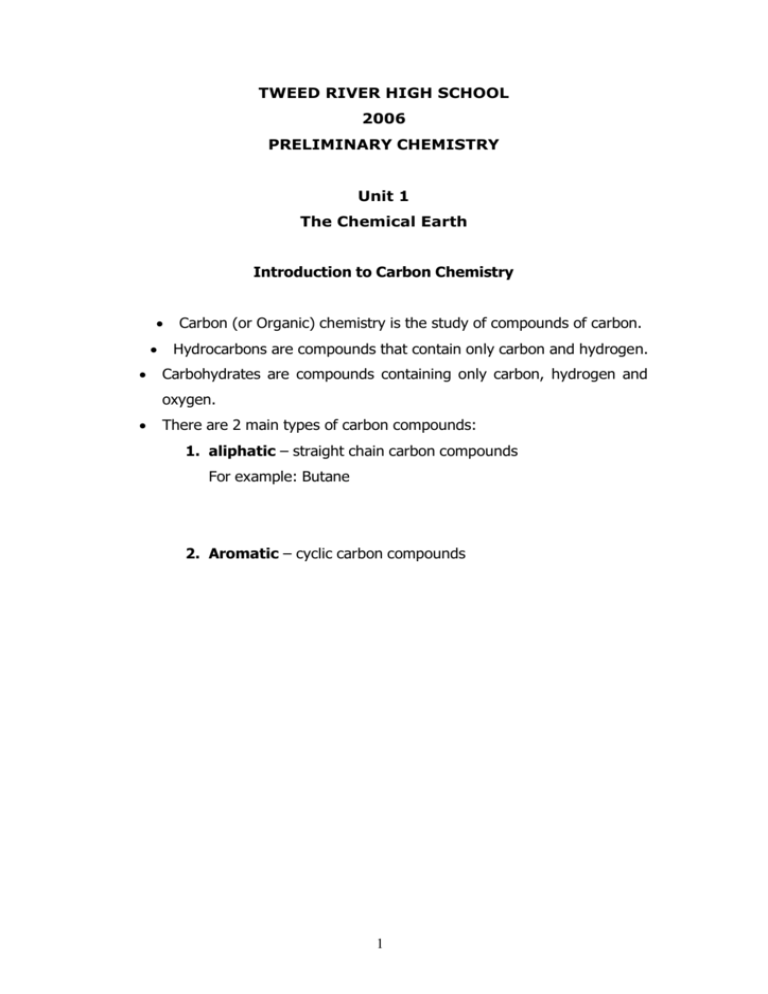
TWEED RIVER HIGH SCHOOL 2006 PRELIMINARY CHEMISTRY Unit 1 The Chemical Earth Introduction to Carbon Chemistry Carbon (or Organic) chemistry is the study of compounds of carbon. Hydrocarbons are compounds that contain only carbon and hydrogen. Carbohydrates are compounds containing only carbon, hydrogen and oxygen. There are 2 main types of carbon compounds: 1. aliphatic – straight chain carbon compounds For example: Butane 2. Aromatic – cyclic carbon compounds 1 Aliphatic Carbon Compounds These are ‘straight chain’ hydrocarbons. For example: propane -C–C–C– There are 3 types of aliphatic carbon compounds. These compounds all belong to a homologous series. A homologous series is a family of compounds which can be represented by one general molecular formula. 1. Alkanes Every carbon atom has four bonds around it. Alkanes are carbon compounds that only have one bond between each carbon atom. When naming alkanes the compound is named as a derivative of the hydrocarbon having the longest carbon chain. Alkanes have the ending –ane on their name and are named according to the following stems: Stem No of Name Formula carbons Meth 1 Methane CH4 Eth 2 Ethane C2H6 Prop 3 Propane C3H8 but 4 Butane C4H10 Pent 5 Pentane C5H12 Hex 6 Hexane C6H14 Hept 7 Heptane C7H16 2 Structure Oct 8 Octane C8H18 Non 9 Nonane C9H20 dec 10 Decane C10H22 Alkanes belong to the homologous series CnH2n+2 3 2. Alkenes There is at least one carbon – carbon double bond in the straight chain. Alkenes have the ending -ene. Naming Alkenes Alkenes have the appropriate stem and where longer chains occur, numbers are used to identify where the double bond is. The double bond is always given the smallest possible number. Stem Name Formula Eth Ethene C2H4 Prop Propene C3H6 But Butene C4H8 Pent Pentene C5H10 Hex Hexene C6H12 Hept Heptene C7H14 Oct Octene C8H16 Non Nonene C9H18 Dec Decene C10H20 Alkenes belong to the homologous series CnH2n 4 3. Alkynes There is at least one carbon- carbon triple bond in the straight chain. Alkynes have the ending -yne. Naming Alkynes Alkynes have the appropriate stem and where longer chains occur, numbers are used to identify where the triple bond is. The triple bond is always given the smallest possible number. Stem Name Formula Eth Ethyne C2H2 Prop Propyne C3H4 But Butyne C4H6 Pent Pentyne C5H8 Hex Hexyne C6H10 Hept Heptyne C7H12 Oct Octyne C8H14 Non Nonyne C9H16 Dec Decyne C10H18 Alkynes belong to the homologous series CnH2n-2 5 Summary Tables for Naming Carbon Compounds TABLE 1: Prefixes for naming carbon chains Prefix meth eth prop but pent hex hept oct non dec Number of Carbon atoms in the chain 1 2 3 4 5 6 7 8 9 10 TABLE 2: Hydrocarbons: compounds which contain only carbon and hydrogen Type of Compound Alkyl group Prefix Suffix see TABLE 1 -yl see TABLE 1 -ane Functional Group Example Name Alkane less 1 terminal ethyl (side-chain or branch) Alkane Alkene Alkyne Cyclic Hydrocarbons contains single bonds between carbon atoms ethane contains a see TABLE 1 -ene see TABLE 1 -yne contains a triple bond between 2 carbon atoms ethyne cyclo -ane, ene or yne (as above) carbon atoms form a ring cyclopropane ethene between 2 TABLE 3: Compounds containing carbon, hydrogen and oxygen Class of Compound Alkanol Suffix -ol Functional Group -OH (alkyl alcohol) (hydroxyl) (alcohol) 6 General Example Formula R-OH Name ethanol (aldehyde) Alkanoic Ester acid (carboxylic acid) -oic acid R-COOH ethanoic acid (carboxyl) alk yl ano ate R-COO-R' methyl ethan oate Branches (Side Chains) Branches are small aliphatic groups attached to an aliphatic chain. Branches are named in alphabetical order, i.e. but, eth, hept, hex etc. The compound must be named to give it the smallest numbers possible. Branches are named by adding –yl to the stem, e.g. methyl, ethyl 7 IUPAC Rules for Alkane Nomenclature 1. Find and name the longest continuous carbon chain. 2. Identify and name groups attached to this chain. 3. Number the chain consecutively, starting at the end nearest a substituent group. 4. Designate the location of each substituent group by an appropriate number and name. 5. Assemble the name, listing groups in alphabetical order using the full name (e.g. cyclopropyl before isobutyl). The prefixes di, tri, tetra etc., used to designate several groups of the same kind, are not considered when alphabetizing. There are two skills you have to develop in this area: You need to be able to translate the name of an organic compound into its structural formula. You need to be able to name a compound from its given formula. The first of these is more important (and also easier!) than the second. In an exam, if you can't write a formula for a given compound, you aren't going to know what the examiner is talking about and could lose lots of marks. However, you might only be asked to write a name for a given formula once in a whole exam - in which case you only risk 1 mark. So, we're going to look mainly at how you decode names and turn them into formulae. In the process you will also pick up tips about how to produce names yourself. In the early stages of an organic chemistry course people frequently get confused and daunted by the names because they try to do too much at once. Don't try to read all these pages in one go. Just go as far as the compounds you are interested in at the moment and ignore the rest. Come back to them as they arise during the natural flow of your course. 8 Cracking the code A modern organic name is simply a code. Each part of the name gives you some useful information about the compound. For example, to understand the name 2-methylpropan-1-ol you need to take the name to pieces. The prop in the middle tells you how many carbon atoms there are in the longest chain (in this case, 3). The an which follows the "prop" tells you that there aren't any carbon-carbon double bonds. The other two parts of the name tell you about interesting things which are happening on the first and second carbon atom in the chain. Any name you are likely to come across can be broken up in this same way. Counting the carbon atoms You will need to remember the codes for the number of carbon atoms in a chain up to 6 carbons. There is no easy way around this - you have got to learn them. If you don't do this properly, you won't be able to name anything! code no of carbons meth 1 eth 2 prop 3 but 4 pent 5 hex 6 9 Types of carbon-carbon bonds Whether or not the compound contains a carbon-carbon double bond is shown by the two letters immediately after the code for the chain length. code means an only carbon-carbon single bonds en contains a carbon-carbon double bond For example, butane means four carbons in a chain with no double bond. Propene means three carbons in a chain with a double bond between two of the carbons. Alkyl groups Compounds like methane, CH4, and ethane, CH3CH3, are members of a family of compounds called alkanes. If you remove a hydrogen atom from one of these you get an alkyl group. For example: A methyl group is CH3. An ethyl group is CH3CH2. These groups must, of course, always be attached to something else. Types of compounds The alkanes Example 1: Write the structural formula for 2-methylpentane. Start decoding the name from the bit that counts the number of 10 carbon atoms in the longest chain - pent counts 5 carbons. Are there any carbon-carbon double bonds? No - an tells you there aren't any. Now draw this carbon skeleton: Put a methyl group on the number 2 carbon atom: Does it matter which end you start counting from? No - if you counted from the other end, you would draw the next structure. That's exactly the same as the first one, except that it has been flipped over. Finally, all you have to do is to put in the correct number of hydrogen atoms on each carbon so that each carbon is forming four bonds. If you had to name this yourself: Count the longest chain of carbons that you can find. Don't assume that you have necessarily drawn that chain horizontally. 5 carbons means pent. Are there any carbon-carbon double bonds? No therefore pentane. There's a methyl group on the number 2 carbon therefore 2-methylpentane. Why the number 2 as opposed to the number 4 carbon? In other words, why do we choose to number from this particular end? The convention is that you number from the end which produces the lowest numbers in the name - hence 2rather than 4-. Example 2: Write the structural formula for 11 2,3-dimethylbutane. Start with the carbon backbone. There are 4 carbons in the longest chain (but) with no carbon-carbon double bonds (an). This time there are two methyl groups (di) on the number 2 and number 3 carbon atoms. Completing the formula by filling in the hydrogen atoms gives: Note: Does it matter whether you draw the two methyl groups one up and one down, or both up, or both down? Not in the least! Example 3: Write the structural formula for 2,2dimethylbutane. This is exactly like the last example, except that both methyl groups are on the same carbon atom. Notice that the name shows this by using 2,2- as well as di. The structure is worked out as before: Example 4: Write the structural formula for 3-ethyl-2methylhexane. 12 hexan shows a 6 carbon chain with no carbon-carbon double bonds. This time there are two different alkyl groups attached - an ethyl group on the number 3 carbon atom and a methyl group on number 2. Filling in the hydrogen atoms gives: Note: Once again it doesn't matter whether the ethyl and methyl groups point up or down. You might also have chosen to start numbering from the right-hand end of the chain. These would all be perfectly valid structures. All you would have done is to rotate the whole molecule in space, or rotate it around particular bonds. If you had to name this yourself: How do you know what order to write the different alkyl groups at the beginning of the name? The convention is that you write them in alphabetical order - hence ethyl comes before methyl which in turn comes before propyl. The cycloalkanes In a cycloalkane the carbon atoms are joined up in a ring hence cyclo. Example: Write the structural formula for cyclohexane. hexan shows 6 carbons with no carbon-carbon double bonds. cyclo shows that they are in a ring. Drawing the ring and putting in the correct number of hydrogens to satisfy the bonding requirements of the carbons gives: 13 The alkenes Example 1: Write the structural formula for propene. prop counts 3 carbon atoms in the longest chain. en tells you that there is a carbon-carbon double bond. That means that the carbon skeleton looks like this: Putting in the hydrogens gives you: Example 2: Write the structural formula for but-1-ene. but counts 4 carbon atoms in the longest chain and en tells you that there is a carbon-carbon double bond. The number in the name tells you where the double bond starts. No number was necessary in the propene example above because the double bond has to start on one of the end carbon atoms. In the case of butene, though, the double bond could either be at the end of the chain or in the middle - and so the name has to code for the its position. The carbon skeleton is: And the full structure is: Incidentally, you might equally well have decided that the righthand carbon was the number 1 carbon, and drawn the structure as: 14 Example 3: Write the structural formula for 3-methylhex-2-ene. The longest chain has got 6 carbon atoms (hex) with a double bond starting on the second one (-2-en). But this time there is a methyl group attached to the chain on the number 3 carbon atom, giving you the underlying structure: Adding the hydrogens gives the final structure: Be very careful to count the bonds around each carbon atom when you put the hydrogens in. It would be very easy this time to make the mistake of writing an H after the third carbon - but that would give that carbon a total of 5 bonds. Compounds containing halogens Example 1: Write the structural formula for 1,1,1trichloroethane. This is a two carbon chain (eth) with no double bonds (an). There are three chlorine atoms all on the first carbon atom. Example 2: Write the structural formula for 2-bromo-2methylpropane. First sort out the carbon skeleton. It's a three carbon chain with no double bonds and a methyl group on the second carbon atom. Draw the bromine atom which is also on the second carbon. 15 And finally put the hydrogen atoms in. If you had to name this yourself: Notice that the whole of the hydrocarbon part of the name is written together - as methylpropane - before you start adding anything else on to the name. Example 2: Write the structural formula for 1-iodo-3methylpent-2-ene. This time the longest chain has 5 carbons (pent), but has a double bond starting on the number 2 carbon. There is also a methyl group on the number 3 carbon. Now draw the iodine on the number 1 carbon. Giving a final structure: Note: You could equally well draw this molecule the other way round, but normally where you have, say, 1-bromo-something, you tend to write the bromine (or other halogen) on the right-hand end of the structure. Alcohols All alcohols contain an -OH group. This is shown in a name by the ending ol. Example 1: Write the structural formula for methanol. This is a one carbon chain with no carbon-carbon double bond (obviously!). The ol ending shows it's an alcohol and so contains 16 an -OH group. Example 2: Write the structural formula for 2-methylpropan-1ol. The carbon skeleton is a 3 carbon chain with no carbon-carbon double bonds, but a methyl group on the number 2 carbon. The -OH group is attached to the number 1 carbon. The structure is therefore: Example 3: Write the structural formula for ethane-1,2-diol. This is a two carbon chain with no double bond. The diol shows 2 -OH groups, one on each carbon atom. Note: There's no particular significance in the fact that this formula has the carbon chain drawn vertically. If you draw it horizontally, unless you stretch the carbon-carbon bond a lot, the -OH groups look very squashed together. Drawing it vertically makes it look tidier! 17
